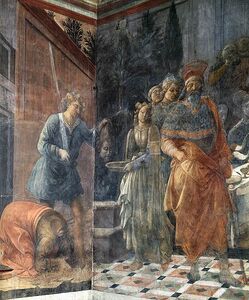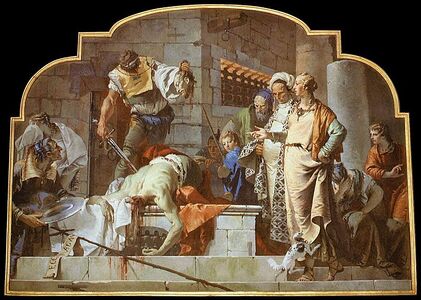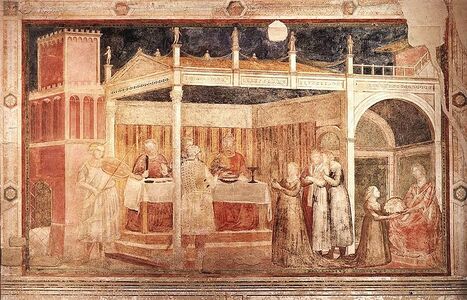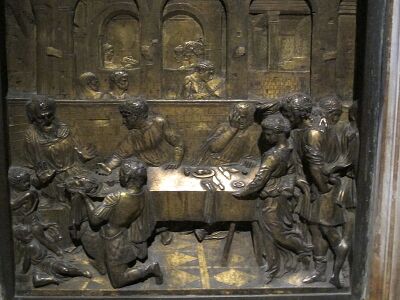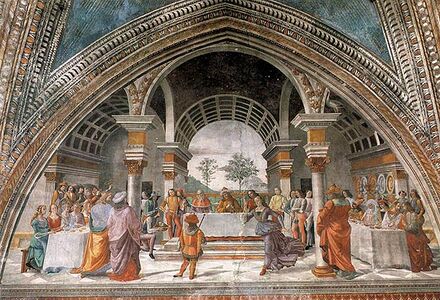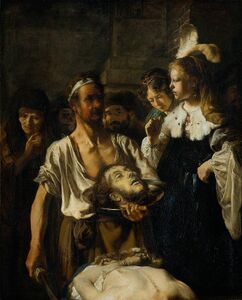Category:Death of John the Baptist (subject)
The Death of John the Baptist refers to an episode in the life of John the Baptist. Since the Baptist was sentenced to death, his execution involves other characters: King Herod Antipas and his family (wife Herodias and step-daughter Salome).
The event is narrated with legendary traits (as the Banquet of Herod) in the Gospel of Mark (6:14-29) and in the Gospel of Matthew (14:1-12). It is only briefly mentioned in the Gospel of Luke (9:7-9) and in the writings of Josephus.
In its reception history, the event would be understood as the central episode in the life of Salome, who gradually replaced Herod Antipas and Herodias as the villain of the narrative.
- People : John the Baptist -- Herod Antipas -- Herodias -- Salome
- Subplots : Salome's Dance -- Beheading of John the Baptist -- Salome Presenting the Head of the Baptist to Herodias -- Carrying of the Body of John the Baptist -- Burial of John the Baptist
< Life of John the Baptist : Annunciation to Zacharias -- Visitation of Mary -- Birth of John the Baptist -- Child John the Baptist with Jesus -- Young John the Baptist in the Desert -- Preaching of John the Baptist -- Baptism of Jesus -- Question about Fasting -- Messengers from John the Baptist -- Death of John the Baptist -- Question about Authority -- Relics of John the Baptist >
Overview
The complex plot of Herodias, which led to the beheading of John the Baptist, is told only in the Gospel of Mark and in the Gospel of Matthew. According to this legend, Herodias took advantage of the promise of reward that Herod Antipas made to her daughter (Salome) for dancing in his presence. Prompted by her mother, Salome asked for the head of the Baptist.
The Gospel of Luke (which is more historically oriented) omitted the legend of the banquet of Herod, while confirming that Herod Antipas executed John. So did Josephus, who added the detail that John was imprisoned and killed in the fortress of Machaerus. The narrative of the death of John the Baptist is absent in the Gospel of John, which however alluded to it confirming that John the Baptist was "put to prison."
The legendary narrative of Mark and Matthew includes various elements that would captivate the readers' imagination for centuries to come. The character of Salome would gradually emerge from being the innocent instrument of her mother's wrath to that of the mischievous (and even sadistic) protagonist of the entire story.
Death of John the Baptist, in ancient sources
Gospel of Mark
Mark 6:14-29 (NRSV) -- [14] King Herod heard of it, for Jesus' name had become known. Some were saying, "John the baptizer has been raised from the dead; and for this reason these powers are at work in him." 15 But others said, "It is Elijah." And others said, "It is a prophet, like one of the prophets of old." 16 But when Herod heard of it, he said, "John, whom I beheaded, has been raised." 17 For Herod himself had sent men who arrested John, bound him, and put him in prison on account of Herodias, his brother Philip's wife, because Herod had married her. 18 For John had been telling Herod, "It is not lawful for you to have your brother's wife." 19 And Herodias had a grudge against him, and wanted to kill him. But she could not, 20 for Herod feared John, knowing that he was a righteous and holy man, and he protected him. When he heard him, he was greatly perplexed; and yet he liked to listen to him. 21 But an opportunity came when Herod on his birthday gave a banquet for his courtiers and officers and for the leaders of Galilee. 22 When his daughter Herodias came in and danced, she pleased Herod and his guests; and the king said to the girl, "Ask me for whatever you wish, and I will give it." 23 And he solemnly swore to her, "Whatever you ask me, I will give you, even half of my kingdom." 24 She went out and said to her mother, "What should I ask for?" She replied, "The head of John the baptizer." 25 Immediately she rushed back to the king and requested, "I want you to give me at once the head of John the Baptist on a platter." 26 The king was deeply grieved; yet out of regard for his oaths and for the guests, he did not want to refuse her. 27 Immediately the king sent a soldier of the guard with orders to bring John's head. He went and beheaded him in the prison, 28 brought his head on a platter, and gave it to the girl. Then the girl gave it to her mother. 29 When his disciples heard about it, they came and took his body, and laid it in a tomb.
Gospel of Matthew
Matthew 14:1-12 (NRSV) -- [1] At that time Herod the ruler heard reports about Jesus; 2 and he said to his servants, "This is John the Baptist; he has been raised from the dead, and for this reason these powers are at work in him." 3 For Herod had arrested John, bound him, and put him in prison on account of Herodias, his brother Philip's wife, 4 because John had been telling him, "It is not lawful for you to have her." 5 Though Herod wanted to put him to death, he feared the crowd, because they regarded him as a prophet. 6 But when Herod's birthday came, the daughter of Herodias danced before the company, and she pleased Herod 7 so much that he promised on oath to grant her whatever she might ask. 8 Prompted by her mother, she said, "Give me the head of John the Baptist here on a platter." 9 The king was grieved, yet out of regard for his oaths and for the guests, he commanded it to be given; 10 he sent and had John beheaded in the prison. 11 The head was brought on a platter and given to the girl, who brought it to her mother. 12 His disciples came and took the body and buried it; then they went and told Jesus.
Gospel of Luke
Luke 9:7-9 (NRSV) -- [7] Now Herod the ruler heard about all that had taken place, and he was perplexed, because it was said by some that John had been raised from the dead, [8] by some that Elijah had appeared, and by others that one of the ancient prophets had arisen. [9] Herod said, "John I beheaded; but who is this about whom I hear such things?" And he tried to see him.
Josephus
Ant XVIII 5, 2 -- Now some of the Jews thought that the destruction of Herod's army [by the Nabateans] came from God, and that very justly, as a punishment of what he did against John, that was called the Baptist: for Herod slew him... Herod, who feared lest the great influence John had over the people might put it into his power and inclination to raise a rebellion, (for they seemed ready to do any thing he should advise,) thought it best, by putting him to death, to prevent any mischief he might cause, and not bring himself into difficulties, by sparing a man who might make him repent of it when it would be too late. Accordingly he was sent a prisoner, out of Herod's suspicious temper, to Machaerus, the castle I before mentioned, and was there put to death. Now the Jews had an opinion that the destruction of this army was sent as a punishment upon Herod, and a mark of God's displeasure to him.
Cf. Gospel of John
John 3:23-24 -- [23] ...people were coming and being baptized [24] for John had not yet been put in prison...
Herod's Banquet
Salome's Dance
"When Herod's birthday came, the daughter of Herodias danced before the company, and she pleased Herod 7 so much that he promised on oath to grant her whatever she might ask" (Mt 14:6-7; cf. Mk 6:21-23).
The Dance of young Salome before Herod Antipas on occasion of the king's birthday triggered Herodias's vengeance against John the Baptist. A colorful and intriguing detail in the narrative, in popular imagination the dance took a life of its own as an exotic and lustful tool of seduction (the Dance of the Seven Veils).
Beheading of John the Baptist
"The king sent a soldier of the guard with orders to bring John's head. He went and beheaded him in the prison" (Mk 6:27; cf. Mt 14:9-10).
That John the Baptist was beheaded is affirmed not only in Mark and Matthew, but also in the Gospel of Luke, which preserves the statement by Herod: "John, whom I beheaded." The Gospel of John only mention that John the Baptist was put in prison, while Josephus does not specify the kind of death John suffered.
In early Christian iconography, the actual beheading was rarely depicted, as a marginal elements in representations of Herod's Banquet (Gozzoli, Lippi). It then became a powerful scene of its own in the works of artists like Danti, Caravaggio, Tiepolo or Puvis de Chavannes.
Presentation of the Head of the Baptist
"(A soldier of the guard) brought (the head) on a platter, and gave it to the girl. Then the girl gave it to her mother" (Mk 6:28); "The head was brought on a platter and given to the girl, who brought it to her mother" (Mt 14:11).
The gruesome detail that the girl Salome received the head of the Baptist "on a platter", became the distinctive feature in the iconographic representations of Salome, making her a sort of evil (and younger) version of Judith.
In the "original" sequence of events, according to Mark and Matthew, Salome received the head of the Baptist by the executioner and brought it not to Herod Antipas but to her mother Herodias.
It is not said that the head of the Baptist was also presented to Herod, but gradually this interpretation became central in every representation of Herod's Banquet. In earlier versions the head is carried by a soldier or servant on a platter (Donatello), later on (Cranach, Rubens) it is Salome herself who did it.
Carrying and Burial of the Body of John the Baptist
"When his disciples heard about it, they came and took his body and laid it in a tomb" (Mk 6:29; "His disciples came and took the body and buried it" (Mt 14:12).
The event is rarely represented, sometimes as two distinct episodes.
Death of John the Baptist, in the arts
Death of John the Baptist, in cinema
- King of Kings (1961 Ray), film
- Pasolini -- Follows the Gospel of Matthew
- Zeffirelli
External links
Pages in category "Death of John the Baptist (subject)"
The following 200 pages are in this category, out of 231 total.
(previous page) (next page)1
- Banquet of Herod (1320 Giotto), art
- Feast of Herod (1427 Donatello), art
- Dance of Salome (1462 Gozzoli), art
- Banquet of Herod (1465 Lippi), art
- Beheading of John the Baptist (1465 Lippi), art
- Herod's Banquet ( (1490 Ghirlandaio), art
- Banquet of Herod (1531 Cranach), art
- Beheading of St John the Baptist (1571 Danti), art
- Feast of Herod (1638 Rubens), art
- Beheading of John the Baptist (1640 Fabritius), art
- San Giovanni Battista (St. John the Baptist / 1675 Stradella / Ansaldi), oratorio
- L'Erodiade; ovvero, La morte di S. Giovanni Battista (Herodias; or, The Death of St. John the Baptist / 1687 Legrenzi / Neri), oratorio
- La decollazione di S. Giovanni Battista (1699 Ingegneri), oratorio
- La decollazione del S. Precursore Giovanni Battista (1708 Arresti / Grappelli), oratorio
- La decollazione di San Giovanni Battista (1709 Bononcini), oratorio
- La fede sacrilega nella morte del Precursore S. Giovanni Battista (Sacrilegious Faith in the Death of the Precursor, St. John the Baptist / 1714 Fux / Pariati), oratorio
- La decollazione di San Giovanni Battista (1715 Grimani), oratorio
- La decollazione di San Giovanni Battista (1721 Predieri), oratorio
- Il Batista (John the Baptist / 1727 Caldara / Zeno), oratorio (music & libretto), Vienna premiere (cast)
- Erodiade (Herodias / 1832 Pellico), play
- Erodiade (Herodias / 1838 Liberali / De Horatiis), oratorio
- Atta Troll (1843 Heine), poetry
- Salome, the Daughter of Herodias (1862 Heywood), play
- Beheading of John the Baptist (1869 Puvis de Chavannes), art
- Herodias (1872 Lévy), art
- Hérodias (1877 Flaubert), novel
- Hérodiade (Salome / 1887 Mallarmé), poetry
- Hérodiade (Herodias / 1881 Massenet / Milliet, Grémont), opera & libretto
- Erodiade, Italian ed. (Herodias / 1884 Gialdini / @1881 Massenet), Paris production (opera)
- Erodiade, Italian ed. (Herodias / 1886 Mascheroni / @1881 Massenet), Bologna production (opera)
- Σαλώμη (Salome / 1896 Cavafy), poetry
- Hérodiade (Herodias / 1903 Luigini / @1881 Massenet), Paris production (opera)
- Salomé = Hérodiade (Herodias / 1904 Lohse / @ 1881 Massenet), London production (opera)
- Salome, English ed. (1905 Farr / @1893 Wilde), London production (play)
- Tanz der Salome (Salome's Dance / 1906 Messter), short film
- If You Had a Wife Like This (1907 Biograph), short film
- Salome (1907 Gaumont), short film
- Salome (1907 Lubin), short film
- La tragédie de Salomé (The Tragedy of Salome / 1907 Schmitt), ballet
- Salome (1907 Strauss, Destinn / @1905 Strauss), sound recording (opera)
- Salome; or, The Dance of Seven Veils (1908 Blackton), short film
- Salomé (1908 Capellani), short film
- L'inconsciente Salomé (Salome / 1908 Feuillade), short film
- Salomé (1908 Mariotte / @1908 Mariotte), Lyon production, world premiere (opera)
- Salomé (1908 Mariotte / Wilde), opera
- The Great Salome Dance (1908 Tyler), short film
- Hérodiade (Herodias / 1909 Fuente / @1881 Massenet), New York production (opera)
- Salomé (1910 Amalou / @1908 Mariotte), Paris production (opera)
- Salome (1910 Falena), short film
- Hérodiade (Herodias / 1910 Jasset, Hatot), short film
- Hérodiade (Herodias / 1911 Amalou / @1881 Massenet), Paris production (opera)
- La figlia d'Erodiade (The Daughter of Herodias / 1916 Falena), short film
- Salomé (1919 Ruhlmann / @1908 Mariotte), Paris production (opera)
- Salomé, vierge folle (Salome, Mad Virgin / 1920 Raphaël), opera
- Hérodiade (Herodias / 1921 Gaubert / @1881 Massenet), Paris production (opera)
- Salome (1922 Bryant), feature film
- Salome, English ed. (1922 @1893 Wilde / Eric), Broadway production (play)
- Salome (1923 Strauss), film
- Salome, English ed. (1923 @1893 Wilde), Broadway production (play)
- Salome (1924 Coates, Ljungberg / @1905 Strauss), sound recording (opera)
- Hérodiade (Herodias / 1928 Cloëz / @1881 Massenet), sound recording (opera)
- Die Doper; of, Die Herodes-Treurspel (The Baptist; or, The Herod-Tragedy / 1928 Müller), play (Afrikaans)
- Salome, English ed. (1931 @1893 Wilde / Price), London production (play)
- Salome (1934 Bodanzky, Ljungberg / @1905 Strauss), New York (Met) production, sound recording (opera)
- Salome (1934 Horton, Montaya), ballet
- Salome (1937 Horton, Lewitzky), ballet
- Salome (1942 Strauss, Schulz / @1905 Strauss), Vienna production, sound recording (opera)
- Salome (1945 Sébastian, Djanel / @1905 Strauss), San Francisco production, sound recording (opera)
- Salome (1947 Krauss, Cebotari / @1905 Strauss), London production, sound recording (opera)
- Salome (1948 Ifukube), ballet
- Salome (1948 Keilberth, Goltz / @1905 Strauss), sound recording (opera)
- Salome (1948 Perlea, Djanel / @1905 Strauss), Florence production (opera)
- The Dance of Salome (1949 Franca / Hartley), TV film (ballet)
- Salome, English ed. (1949 Rankl, Welitsch / @1905 Strauss), London production (opera)
- Salome (1949 Reiner, Welitsch / @1905 Strauss), New York (Met) production, sound recording (opera)
- San Giovanni Battista (St. John the Baptist / 1949 Santini / @1675 Stradella), Perugia production (oratorio)
- Salome (1951 Keilberth, Borkh / @1905 Strauss), Munich production, sound recording (opera)
- Salome (1952 Moralt, Wegner / @1905 Strauss), sound recording (opera)
- Salome (1952 Reiner, Welitsch / @1905 Strauss), New York (Met) production, sound recording (opera)
- Salome, Italian ed. (1952 Sanzogno, Djanel / @1905 Strauss), sound recording (opera)
- Salome (1952 Schröder, Borkh / @1905 Strauss), sound recording (opera)
- Salome; or, The Face of Violence (1953 Horton, Lavallade), ballet
- Salome (1953 Weigert, Varnay / @1905 Strauss), sound recording (opera)
- Salome, Swedish ed. (1954 Ehrling, Nilsson / @1905 Strauss), Stockholm production, sound recording (opera)
- Salome (1954 Krauss, Goltz / @1905 Strauss), sound recording (opera)
- Omnibus: Salome (1955 / @1893 Wilde), TV production (play)
- Salome (1955 Mitropoulos, Goltz / @1905 Strauss), New York (Met) production, sound recording (opera)
- Miss Salome (1955 Truitte / @1953 Horton), ballet
- Salomé, Portuguese ed. (1956 Filho, Gallon / @1893 Wilde), TV production (play)
- Salome (1957 @1905 Strauss / Goehr), TV production (opera)
- Salome (1957 Varviso, Caballé / @1905 Strauss), Basel production, sound recording (opera)
- Hérodiade (Herodias / 1957 Wolff / @1881 Massenet), sound recording (opera)
- Salome (1958 Mitropoulos, Borkh / @1905 Strauss), New York (Met) production, sound recording (opera)
- Salome (1958 Quennet, Goltz / @1905 Strauss), Duisberg production, sound recording (opera)
- San Giovanni Battista (St. John the Baptist / 1960 Cillario / @1675 Stradella), sound recording (oratorio)
- Salome (1960 Kempe, Borkh / @1905 Strauss), Munich production, sound recording (opera)
- Hérodiade (Herodias / 1961 Etcheverry / @1881 Massenet), sound recording (opera)
- Salome (1961 Schippers, Tynes / @1905 Strauss), Spoleto production, sound recording (opera)
- Salome (1961 Solti, Nilsson / @1905 Strauss), sound recording (opera)
- Hérodiade (Herodias / 1963 Dervaux / @1881 Massenet), sound recording (opera)
- Hérodiade (Herodias / 1963 Lombard / @1881 Massenet), New York production, sound recording (opera)
- Hérodiade (Herodias / 1963 Prêtre / @1881 Massenet), sound recording (opera)
- Salome (1963 Suitner, Goltz / @1905 Strauss), Dresden production, sound recording (opera)
- Salome (1965 Böhm, Nilsson / @1905 Strauss), New York (Met) production, sound recording (opera)
- Salome (1965 Keilberth, Weathers / @1905 Strauss), Munich production, sound recording (opera)
- Salome (1965 Kosler, Silja / @1905 Strauss), Vienna production, sound recording (opera)
- Salome (1965 Sébastian, Nilsson / @1905 Strauss), Buenos Aires production, sound recording (opera)
- Salome (1965 Varviso, Pilarczyk / @1905 Strauss), Philadelphia production, sound recording (opera)
- Salome (1967 Klobucar, Nilsson / @1905 Strauss), Milan production, sound recording (opera)
- Salome (1967 Sebastian, Silja / @1905 Strauss), Geneva production, sound recording (opera)
- Salome (1968 Krombholc, Silja / @1905 Strauss), Amsterdam production, sound recording (opera)
- Salome (1968 Leinsdorf, Caballé / @1905 Strauss), sound recording (opera)
- Erodiade (Herodias / 1969 Testori), play
- Salome (1969 Wallberg, Bukovac / @1905 Strauss), Venice production, sound recording (opera)
- Salomé (1969 Koralnik / @1893 Wilde), TV production (play)
- Salome (1970 Böhm, Jones / @1905 Strauss), Hamburg production, sound recording (opera)
- Salome (1970 Gregor, Silja / @1905 Strauss), San Francisco production, sound recording (opera)
- Salome (1971 Leitner, Rysanek / @1905 Strauss), Munich production, sound recording (opera)
- Salome (1971 Mehta, Caballé / @1905 Strauss), radio production, sound recording (opera)
- Salome, German ed. (1971 Schroeter / @1893 Wilde), TV production (play)
- Salome (1972 Böhm, Rysanek / @1905 Strauss), New York (Met) production, sound recording (opera)
- Salome (1972 Böhm, Rysanek / @1905 Strauss), Vienna production, sound recording (opera)
- Salome (1972 Keene, Galvany / @1905 Strauss), Cincinnati production, sound recording (opera)
- Salome; or, The Face of Violence (1973 Truitte / @1953 Horton), ballet
- Salome (1974 Dohnányi, Jones / @1905 Strauss), London production, sound recording (opera)
- Salome (1974 Kempe, Rysanek / @1905 Strauss), Orange production, sound recording (opera)
- Salome (1974 Levine, Bumbry / @1905 Strauss), New York (Met) production, sound recording (opera)
- Hérodiade (Herodias / 1974 Lloyd-Jones / @1881 Massenet), sound recording (opera)
- Salome (1974 Solti, Nilsson / @1905 Strauss), New York (Carnegie) production, sound recording (opera)
- Salome (1974 Suitner, Rysanek / @1905 Strauss), San Francisco production, sound recording (opera)
- Hérodiade (Herodias / 1975 Andersson / @1881 Massenet), New Orleans production, sound recording (opera)
- Salome (1975 Keene, Niska / @1905 Strauss), New York (City Opera) production, sound recording (opera)
- Salome (1975 Kempe, Rysanek / @1905 Strauss), Munich production, sound recording (opera)
- Salome (1975 Schneider, Fecht / @1905 Strauss), Düsseldorf production, sound recording (opera)
- Salome (1975 Sébastian, Schröder-Feinen / @1905 Strauss), Geneva production, sound recording (opera)
- Salome, English ed. (1976 Elder, Barstow / @1905 Strauss), London production, sound recording (opera)
- Salome (1977 Braithwhaite, Tinsley / @1905 Strauss), Brighton production, sound recording (opera)
- Salome (1977 Karajan, Behrens / @1905 Strauss), Salzburg production, sound recording (opera)
- Salome (1977 Rieger, Jones / @1905 Strauss), Munich production, sound recording (opera)
- Salome, Daughter of Herodias (1977 Sams / Janer), opera (music & libretto)
- Hérodiade (Herodias / 1977 Stapleton / @1881 Massenet), Wexford production, sound recording (opera)
- Salome (1978 Klobucar, Bumbry / @1905 Strauss), Chicago production, sound recording (opera)
- Salome, English ed. (1978 Faure / @1893 Wilde), TV production (play)
- San Giovanni Battista (St. John the Baptist / 1979 Müller-Bruhl / @1675 Stradella), sound recording (oratorio)
- Salome (1979 Rudel, Caballé / @1905 Strauss), Madrid production, video recording (opera)
- Salome (1981 Davis, Jones / @1905 Strauss), New York (Met) production, sound recording (opera)
- Salome (1982 Keefe, Galvany / @1905 Strauss), Cincinnati production, sound recording (opera)
- Salome (1983 Stein, Migenes / @1905 Strauss), Geneva production, sound recording (opera)
- Hérodiade (Herodias / 1984 @1881 Massenet / Delacôte), Barcelona production, video recording (opera)
- Erodiade (Herodias / 1984 @1969 Testori / Testori), Milan premiere (play)
- Salome, Catalan ed. (1985 Gas / @1893 Wilde), Mérida production (play)
- San Giovanni Battista (St. John the Baptist / 1986 Basbas / @1675 Stradella), New York production (oratorio)
- Salome (1986 D'Anna), film
- Salome (1987 Nagano, Caballé / @1905 Strauss), Milan production, sound recording (opera)
- Hérodiade (Herodias / 1987 Prêtre / @1881 Massenet), Nice production, sound recording (opera)
- Salome (1987 Tate, Behrens / @1905 Strauss), Munich production, sound recording (opera)
- Salome, French ed. (1989 Guschlbauer, Makris / @1905 Strauss), Montpelier production, sound recording (opera)
- Salome (1989 Janowski, Marton / @1905 Strauss), New York (Met) production, sound recording (opera)
- Salome (1989 Mund, Caballé / @1905 Strauss), Barcelona production, video recording (opera)
- La fede sacrilega nella morte del Precursore S. Giovanni Battista (Sacrilegious Faith in the Death of the Precursor, St. John the Baptist / 1989 Reuber / @1714 Fux), Neuss production, sound recording (oratorio)
- San Giovanni Battista (St. John the Baptist / 1989 Schneider / @1675 Stradella), sound recording (oratorio)
- Salome, French ed. (1990 Nagano, Huffstodt / @1905 Strauss), Lyon production, sound recording (opera)
- San Giovanni Battista (St. John the Baptist / 1991 Minkowski / @1675 Stradella), sound recording (oratorio)
- Salome (1991 Schneider, Zampieri / @1905 Strauss), Vienna production, sound recording (opera)
- Salome (1991 Sinopoli, Malfitano / Weigl, Large / @1905 Strauss), video recording (opera)
- Erodiade (Herodias / 1991 @1969 Testori / Syxty), Milan production (play)
- (+) Salome (1992 Downes, Ewing / Bailey / @1905 Strauss), video recording (opera)
- Salome, English ed. (1992 @1893 Wilde / Ackerman), Broadway production (play)
- Salome (1992 Waart, Barstow / @1905 Strauss), Amsterdam production, video recording (opera)
- Salome (1994 Dohnányi, Malfitano / @1905 Strauss), Vienna production, sound recording (opera)
- Hérodiade (Herodias / 1994 Gergiev / @1881 Massenet), San Francisco production, sound recording (opera)
- Hérodiade (Herodias / 1994 Plasson / @1881 Massenet), Toulouse production, sound recording (opera)
- Salome (1995 Chung, Johnson / @1905 Strauss), Milan production, sound recording (opera)
- Salome (1995 Schneider, Jones / @1905 Strauss), Vienna production, sound recording (opera)
- Hérodiade (Herodias / 1995 Queler / @1881 Massenet), New York production, sound recording (opera)
- Hérodiade (Herodias / 1995 Viotti / @1881 Massenet), Vienna production, sound recording (opera)
- Salome (1997 Dohnányi, Malfitano / Bondy, Hulscher / @1905 Strauss), London production, video recording (opera)
- Salome (1997 Schønwandt, Nielsen / @1905 Strauss), sound recording (opera)
- The Feast of Herod (1998 Colvin), art
- Salome (1990 Mehta, Marton / @1905 Strauss), Berlin-Dahlem production, sound recording (opera)
- Salome (1990 Ozawa, Norman / @1905 Strauss), Dresden production, sound recording (opera)
- Salome (1998 Schneider, Tomowa-Sintow / @1905 Strauss), Barcelona production, sound recording (opera)
- Salome (1990 Sinopoli, Studer / @1905 Strauss), Berlin production, sound recording (opera)
- Erodiàs (Herodias / 1998 @1969 Testori / Tiezzi), Ravenna production (play)
2
- Salome (2000 Delfs, Marc / @1905 Strauss), Milwaukee production, sound recording (opera)
- Hérodiade (Herodias / 2001 @1881 Massenet / Fournillier), Saint-Étienne production, video recording (opera)
- Salome (2001 Ozawa, Voigt / @1905 Strauss), Tanglewood production, sound recording (opera)
- San Giovanni Battista (St. John the Baptist / 2002 Astronio / @1675 Stradella), sound recording (oratorio)
- Hérodiade (Herodias / 2002 Lacombe / @1881 Massenet), Liege production, sound recording (opera)
- Perdersi nella passione (2003 Artale), novel
- Salome (2003 Conlon, Mattila / @1905 Strauss), Paris production, sound & video recording (opera)
- Salome, English ed. (2003 @1893 Wilde / Parsons), Broadway production (play)
- San Giovanni Battista (St. John the Baptist / 2004 Aymes / @1675 Stradella), Marseille production (oratorio)
- Salomé (2005 Layer / @1908 Mariotte), Montpellier production, sound recording (opera)
- Salome (2005 Nagano, Herlitzius / @1905 Strauss), Dresden production, video recording (opera)
- Chiamami Salomé (Call Me Salome / 2005 Sestieri), feature film
- Salome, Spanish ed. (2005 @1893 Wilde / Narros), Seville production (play)
- Salome (2006 Davis, Voigt / @1905 Strauss), Chicago production, sound recording (opera)
- The Trial of Salome (2006 Pavlich), play
Media in category "Death of John the Baptist (subject)"
The following 5 files are in this category, out of 5 total.
- 1608 * Caravaggio (art).jpg 800 × 543; 66 KB
- 1733 * Tiepolo (art).jpg 800 × 570; 116 KB
- 1972 Bene (film).jpg 187 × 270; 17 KB
- 1974 Friedrich (video).jpg 226 × 320; 22 KB
- 2007 Anastasio (short).jpg 182 × 268; 13 KB

